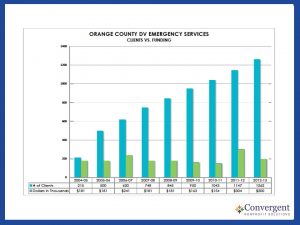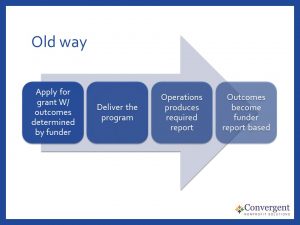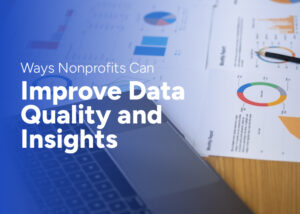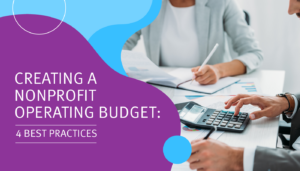Does your case for support look something like this?
“We have to serve more people, so you need to give us more money.”
Unfortunately, many nonprofits tend to put out a similar message. Inevitably, at the end of the fiscal year, you’ll see another one: “We need to serve another 100 people, so we have to raise a certain amount of money or we won’t be able to serve these people.” I call that desperation fundraising.
I’ve done it myself early in my career, but we want you to get away from this type of mentality. It doesn’t help your nonprofit build a brand image that it is successfully moving the needle. In fact, it reinforces the impression that you’re not moving the needle. For most funders, an organization that isn’t moving the needle is not a good investment.
I’d like to share a chart that I developed many years ago when I was going to ask for more funding from local government. Many of you may have developed graphs like this, but I thought I was pretty clever at the time. The green bars, which were relatively flat, represented the funding allocation that they had given my nonprofit. The blue bars, on the other hand, showed a very steady increase in the number of clients we were serving. I thought this made a very, very good case for support to demonstrate that we were consistently serving more people every year and therefore needed more funding.
The response I got back was, “It’s really great you’re doing so much more with the same amount of money. You’ve become much more efficient. We like that in a nonprofit.”
The approach did not get me a single dollar more in funding. I left very frustrated and not able to really tell the story of impact like I needed to. That’s what started me on my personal journey to understanding impact.
I took a step back to think about why I was stuck in this hamster wheel cycle of trying to find money every year. We needed to break out of the routine of first figuring out how much money we had to spend for the year and then determining how much money we had to raise to not end up in the red.
I started thinking about outcomes and asked myself, “How do we really come up with our outcomes?”
This is how most of us have developed our outcomes over the years:
We call them outcomes, but they’re not really outcomes. They are grant deliverables.
It’s time to approach outcomes using a new process. Think about what your organization’s intended outcomes are. Instead of waiting to identify your outcomes at the end of the process, be thinking from the very beginning, “What do people want to invest in? What’s important to them? Where will they put their dollars?”
Now you can execute a strategy developed with your funder(s). You can measure the impact your strategy has on the community and market that impact to gain larger investments. It becomes a cyclical process, but it’s not based on filling out a grant and reporting back on activities we’ve accomplished.
Instead, it’s about moving the needle forward and marketing how you’re moving the needle forward. Now you can grow the investment not only from the original funder(s) but from other funders that hear about the incredible work you’re doing and the impact you’re having on the community.
This post is based on a brief excerpt from the webinar, “Turning Data into Dollars,” part of our series on Impact Funding for Housing and Shelters.








